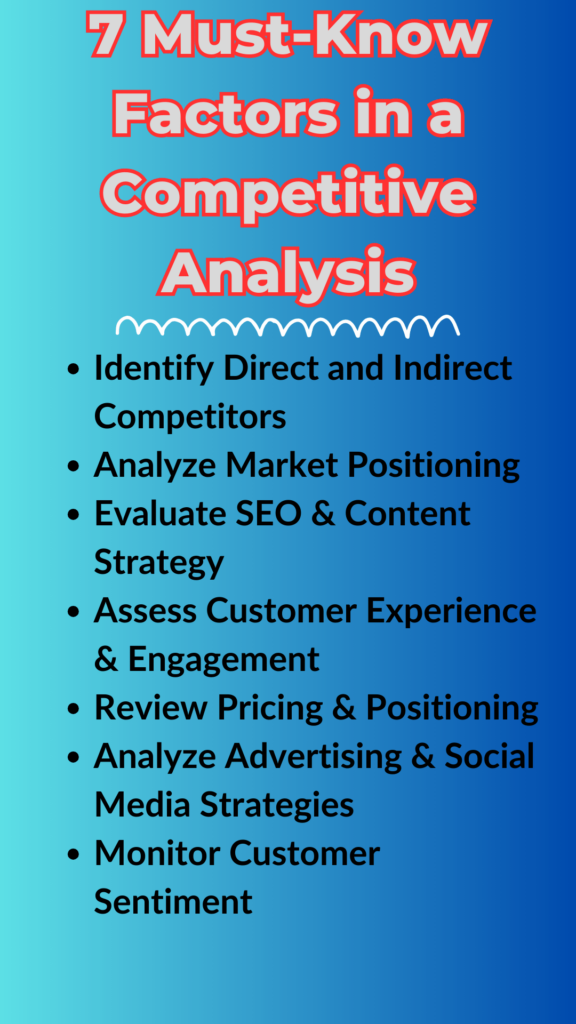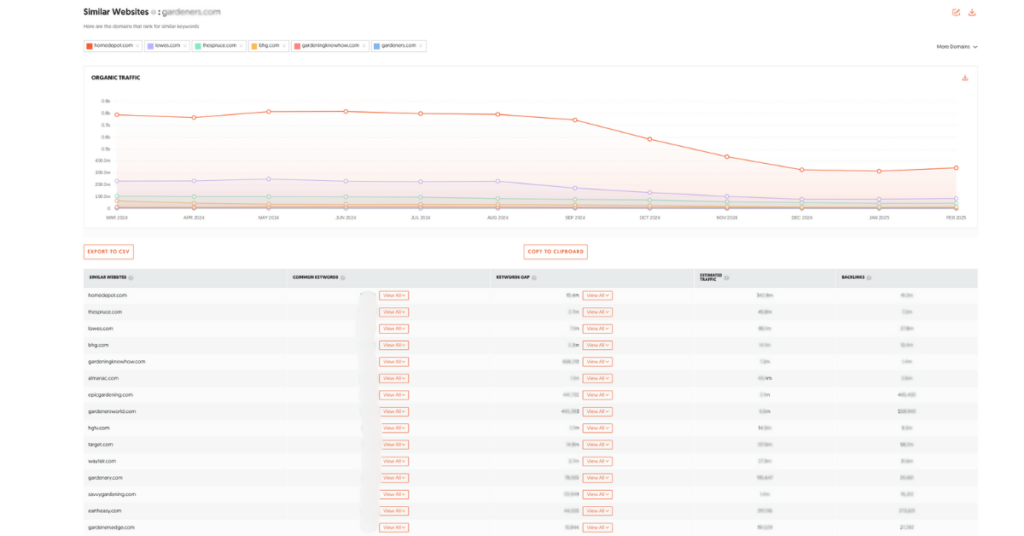Some links on this site are affiliate links, including Amazon affiliate links. As an Amazon Associate, I earn from qualifying purchases. If you click and make a purchase, I may earn a small commission—at no extra cost to you. I only recommend products I genuinely trust and use.
What Is Included in a Competitive Analysis (and Why It Matters)
Your competitors are shaping your success—whether you realize it or not.
In every industry, businesses are fighting for the same audience. Customers have choices; if you don’t understand what your competitors are doing, you’re missing opportunities. A competitive analysis isn’t about copying strategies—it’s about learning what works, what doesn’t, and where you can stand out.

So, why market analysis is important? Because running a business without it is like driving blindfolded. You need clear insights into who your competitors are, how they attract customers, and where you can do better.
But not all competitive research is useful. Some reports are packed with data but lack direction. A smart analysis gives you clear, actionable takeaways that fuel business growth.
This article breaks down what is included in a competitive analysis and highlights seven must-know factors that will give you a competitive edge.
Let’s start with the first and most critical step—knowing who you’re really competing against.
1. Identifying Direct and Indirect Competitors
Your biggest competitor might not be who you think.
Most businesses focus only on others selling the same product. However, the real competition often comes from alternative solutions—businesses meeting the same customer needs in different ways.
- Direct competitors offer the same product or service to the same audience.
- Indirect competitors solve the same problem but with a different approach.
For example, a local gym’s direct competitor might be another gym nearby. But its indirect competitors could be home workout apps, personal trainers, or even free YouTube fitness programs.
Ignoring these players is a costly mistake. It leaves gaps in strategy and allows competitors to take market share without you even noticing.
How Ubersuggest Helps
Instead of making assumptions, use Ubersuggest to find out exactly who you’re competing against.
✔️ Enter your website and instantly get a list of competitors ranking for similar keywords.
✔️ Uncover indirect competitors by analyzing search trends and alternative solutions your audience is looking for.
✔️ See what’s working for them—their best keywords, backlinks, and top-performing content.
Knowing your real competition gives you the insights to stay ahead, not just keep up.
Next, let’s analyze how your competitors position themselves—and how you can stand out.
2. Analyzing Market Positioning: How Your Competitors Win
Why do customers choose your competitors over you?
It’s not always about having the best product. Perception drives decisions. The way a company brands, prices, and markets itself determines who wins and who gets ignored.
This is where market positioning comes in. To compete effectively, you need to know:
- How competitors position their brand—premium, budget-friendly, or niche?
- What their messaging focuses on—quality, price, convenience, or innovation?
- How customers perceive them—trusted leader or just another option?
A business that nails its positioning dominates its niche, even if the product isn’t the best. Without understanding this, you risk blending in instead of standing out.
How Ubersuggest Helps
Instead of spending hours researching manually, let Ubersuggest do the work:
✔️ Analyze competitor websites—see what messaging and branding they emphasize.
✔️ Check their top-ranking content—find out what topics drive their traffic.
✔️ Compare keyword strategies—see how they attract their audience.
Market positioning isn’t about who has the best product. It’s about who owns the best space in the customer’s mind.
Next, let’s dive into a powerful factor that drives online success—SEO and content strategy.
3. SEO & Content Strategy: How Competitors Attract Traffic
If your competitors are ranking higher than you, they’re doing something right.
The secret? A well-executed SEO and content strategy. Businesses that dominate search results aren’t just lucky. They’ve figured out which keywords drive traffic, what content gets engagement, and how to stay ahead of algorithm updates.
Here’s what a competitive SEO analysis should include:
- Top-ranking keywords – Which search terms bring them the most visitors?
- High-performing content – What blog posts, videos, or pages are pulling in traffic?
- Backlink profile – Where are they getting high-authority links from?
- User engagement – How long are visitors staying on their pages?
Without this information, you’re guessing while your competitors are making data-driven moves.
How Ubersuggest Helps
Instead of manually checking competitor websites, use Ubersuggest to analyze their SEO strategy in seconds.
✔️ Find competitor keywords—see what terms are driving their search traffic.
✔️ Identify top-performing content—spot the topics that bring in the most visitors.
✔️ Track backlink sources—discover where they’re getting authority-boosting links.
✔️ Monitor SEO trends—stay ahead of search engine updates and ranking shifts.
Your competitors already did the hard work figuring out what works. A smart competitive analysis lets you leap ahead instead of playing catch-up.
Next, let’s explore a factor that directly impacts conversions—customer experience.
4. Customer Experience & Engagement: Why People Stay or Leave
Your competitor’s website might not have the best product. But if it feels easier to use, loads faster, and looks more trustworthy, customers will choose them over you—every time.
That’s the power of customer experience (CX). A business can have a strong SEO strategy, but if visitors click away within seconds, rankings will drop, and conversions will suffer.
A competitive CX analysis should answer:
- How fast do competitor websites load? A slow site kills sales.
- Is their navigation intuitive? Users shouldn’t have to guess where to go next.
- How do they engage customers? Live chat, email follow-ups, and personalized content make a difference.
- What’s their social proof? Reviews, testimonials, and case studies build trust.
If their experience is better, they’ll win your customers before you even get a chance.
How Ubersuggest Helps
Instead of relying on guesswork, use Ubersuggest to gain real insights into customer engagement strategies.
✔️ Analyze competitor bounce rates—see how long visitors stay on their site.
✔️ Check mobile usability—find out if their site is optimized for phones.
✔️ Review engagement metrics—see how their top content keeps users hooked.
✔️ Compare site speed—a slow-loading site means lost conversions.
People don’t just buy products. They buy experiences. If your competitor offers a smoother, faster, and more engaging journey, they’ll keep winning—unless you level up.
Next, let’s break down how pricing and positioning impact the competitive landscape.
5. Pricing & Positioning: How Competitors Win Customers
Customers don’t just compare products. They compare value.
Some businesses dominate simply because they position themselves better. Maybe they charge premium prices and market themselves as the best in the industry. Or they offer lower prices with a focus on affordability. Either way, their strategy influences customer decisions.
A pricing and positioning analysis should answer:
- What price points do competitors use? Are they premium, mid-range, or budget?
- Do they offer discounts, bundles, or free trials?
- What value do they emphasize? Quality, affordability, exclusivity?
- How do customers perceive them? Trusted brand or just another option?
Get this wrong, and you’ll struggle to attract the right buyers—or worse, price yourself out of the market.
How Ubersuggest Helps
Instead of manually tracking competitor pricing, use Ubersuggest to analyze:
✔️ How competitors position themselves—luxury, budget-friendly, or niche?
✔️ What messaging they use—what convinces customers to choose them?
✔️ Which pages drive conversions—landing pages, sales pages, or pricing tables?
✔️ How their audience engages—what keeps them loyal?
Winning in business isn’t always about lowering prices. It’s about positioning yourself as the best option for the right customers.
Next, let’s talk about the one strategy that can give you a major edge—advertising insights.
6. Advertising & Social Media: Where Competitors Spend Their Money
If your competitors are running ads, they’ve already tested what works—so why start from scratch?
Businesses that scale fast don’t just rely on SEO. They pay for attention. Whether it’s Google Ads, Facebook campaigns, influencer partnerships, or LinkedIn promotions, they know exactly where to put their dollars.
To stay competitive, you need to know:
- Where are they advertising? Search engines, social media, or industry sites?
- What ad messaging do they use? Discounts, authority, urgency?
- How engaged is their audience? Are people commenting, sharing, clicking?
- What platforms drive the most traffic? Some industries thrive on Instagram, others on LinkedIn.
Competitors don’t guess when it comes to paid marketing. They invest where the return is highest.
How Ubersuggest Helps
Manually tracking competitor ads is impossible. That’s where Ubersuggest makes life easier.
✔️ See what keywords they’re bidding on—understand their paid search strategy.
✔️ Analyze competitor social media engagement—track likes, shares, and comments.
✔️ Check ad copy trends—find out what messaging converts best.
✔️ Discover new traffic sources—see where their audience is most active.
If you know where competitors spend their money, you can refine your own strategy and maximize results.
Next, let’s talk about the final—and most overlooked—part of a competitive analysis: customer sentiment.
7. Customer Sentiment: What People Really Think About Your Competitors
Your competitors don’t control their reputation—their customers do.
Reviews, testimonials, and social media conversations shape brand perception more than any marketing campaign ever could. A company with glowing reviews can charge higher prices. One with bad press can lose customers overnight.
A strong competitive analysis should reveal:
- What customers love about competitors—service, quality, price?
- Where they fall short—bad support, slow shipping, poor experience?
- How engaged their audience is—do people rave about them or stay silent?
- What platforms people use to talk about them—Yelp, Trustpilot, Reddit, Twitter?
A business that listens to its competitors’ customers can spot gaps and create a stronger offer.
How Ubersuggest Helps
Instead of scrolling through reviews one by one, use Ubersuggest to pull valuable insights.
✔️ Analyze customer reviews—find common praise and complaints.
✔️ Track brand mentions—see what people say about competitors online.
✔️ Monitor audience engagement—understand how customers interact with them.
✔️ Identify content opportunities—what topics resonate with their audience?
The best businesses don’t just sell—they solve problems competitors ignore.
Now, let’s wrap this up with how to turn insights into action.
Use Competitive Analysis to Win—And Let Ubersuggest Do the Heavy Lifting
Your competitors aren’t guessing. They’re using data to win.
A competitive analysis isn’t about copying—it’s about understanding where your business stands and finding ways to get ahead. By analyzing competitors’ positioning, SEO, content, pricing, ads, and customer sentiment, you can make smarter decisions, avoid costly mistakes, and grow faster.
But doing all this manually? That’s a full-time job.
That’s where Ubersuggest makes life easier. It gives you instant access to the same insights big companies use to outrank, out-market, and outperform the competition.
What Ubersuggest Can Do for You:
✔️ Find your real competitors—both direct and indirect.
✔️ Analyze competitor SEO strategies—keywords, backlinks, and rankings.
✔️ Track top-performing content—see what drives their traffic.
✔️ Discover paid ad strategies—learn where they’re investing their budget.
✔️ Monitor customer sentiment—understand what people love (or hate) about them.
And the best part? Ubersuggest offers a lifetime membership. That means one-time payment, lifetime access—no monthly fees draining your budget.
Your competitors already know what’s working—why not take the shortcut and learn from them?
Run your first competitor analysis with Ubersuggest today and start playing to win. 🚀







